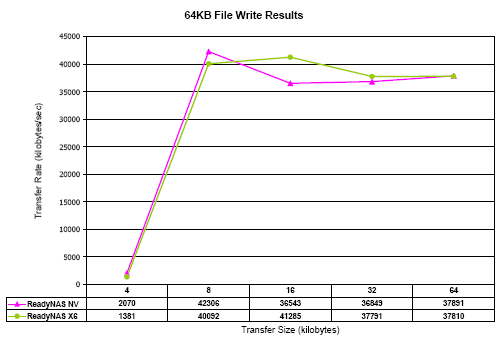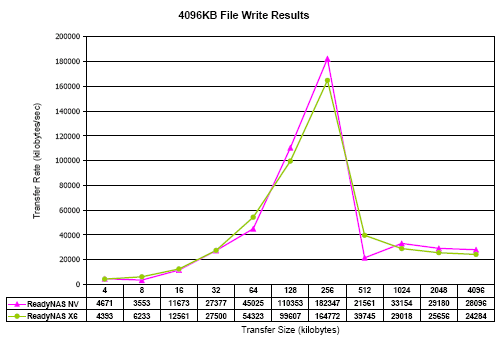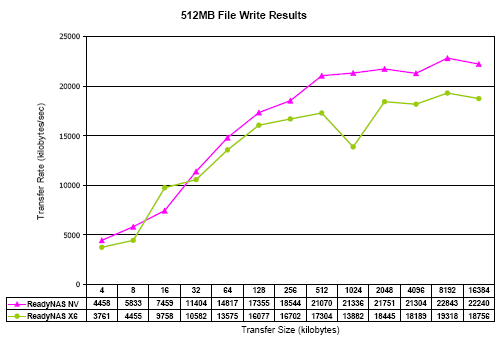Infrant Technologies’ ReadyNAS NV: Enterprise Features, Desktop Footprint
by Purav Sanghani on March 17, 2006 11:42 AM EST- Posted in
- Storage
Iozone Results
Iozone is a command-line benchmark, which is very extensive in testing various combinations of file sizes and transfer sizes to measure average transfer rates. We used the following command to run the benchmark:
Write Benchmarks
Below are the graphed results for the write portion of the Iozone benchmark. To get a better look at how the two ReadyNAS devices compare, we created two separate graphs for each file size tested: one without the Seagate RAID 5 array, and the other, the mouse over image that includes the Seagate results. The comparison between the NAS devices is clearer without the Seagate data on the chart. Alternatively, we have posted the PDFs (graphs) and Excel files (raw data) of the results to provide some extra numbers to look at here.
We see an improvement in performance with the ReadyNAS NV while transferring 512MB and 1GB files, which is great for media servers that serve movies. However, according to our results, transferring audio files will reflect the performance that we ended up with on the last generation ReadyNAS X6.
Iozone is a command-line benchmark, which is very extensive in testing various combinations of file sizes and transfer sizes to measure average transfer rates. We used the following command to run the benchmark:
iozone -Rab [results file name] -i 0 -i 1 -g 1G -+u -f [path to directory on NAS device under test] -zThe output CSV file produced results for re/write and re/read operations as well as the amount of CPU time used during the specified operations. The most important results, however, are the transfer rates for files of the following sizes: 64KB, 4096KB, 512MB, and 1GB. We carefully chose these file sizes to report because we believed these to be the most common sizes of files used on a daily basis by the typical home/small office client.
Write Benchmarks
Below are the graphed results for the write portion of the Iozone benchmark. To get a better look at how the two ReadyNAS devices compare, we created two separate graphs for each file size tested: one without the Seagate RAID 5 array, and the other, the mouse over image that includes the Seagate results. The comparison between the NAS devices is clearer without the Seagate data on the chart. Alternatively, we have posted the PDFs (graphs) and Excel files (raw data) of the results to provide some extra numbers to look at here.

Hold your mouse over to compare to Seagate's 250GB 7200.8 x 4 in RAID 5.

Hold your mouse over to compare to Seagate's 250GB 7200.8 x 4 in RAID 5.

Hold your mouse over to compare to Seagate's 250GB 7200.8 x 4 in RAID 5.

Hold your mouse over to compare to Seagate's 250GB 7200.8 x 4 in RAID 5.
We see an improvement in performance with the ReadyNAS NV while transferring 512MB and 1GB files, which is great for media servers that serve movies. However, according to our results, transferring audio files will reflect the performance that we ended up with on the last generation ReadyNAS X6.










13 Comments
View All Comments
MikeRocker - Friday, March 17, 2006 - link
Sorry, couldn't resist the joke. ;-) Maybe 'perforated' is a more accurate description.Nice piece of kit, though it gets owned by the RAID performance-wise. How much is that actually down to the network interface? Pity its so expensive too.
brownba - Friday, March 17, 2006 - link
ehhh, looks like a space heater to melatrosicarius - Monday, March 20, 2006 - link
I bought one about a month ago. It's good b/c it has RAID-5 on a Gigabit connection. It's small and looks awesome, but the fan is loud as s***. It's basically a micro Linux box.Anyway, I use it as a BACKUP only, b/c it doesn't have a "real" CPU or Mobo and is a tad slow to work from directly. For my Server, I use a real PC with four identical slave drives, also in RAID-5, so the backup can be 1:1. I wish it had RAID-6 b/c my Arcea 1210 RAID controller card in my server has the possibility of RAID-6.
Just FYI, four 300GB Maxtor MaxLineIII 7200RPM SATA drives do work great, even tho they are not listed on the Infrant HW compatability page. It will give you a 1.2TB array (1200GB) of total space if you stripe the 4 drives (RAID-0), and Will give you around 850GB if you use RAID-5 (one quarter of each drive is reserved to cache a third of each other drive so one drive can fail without any data loss.)